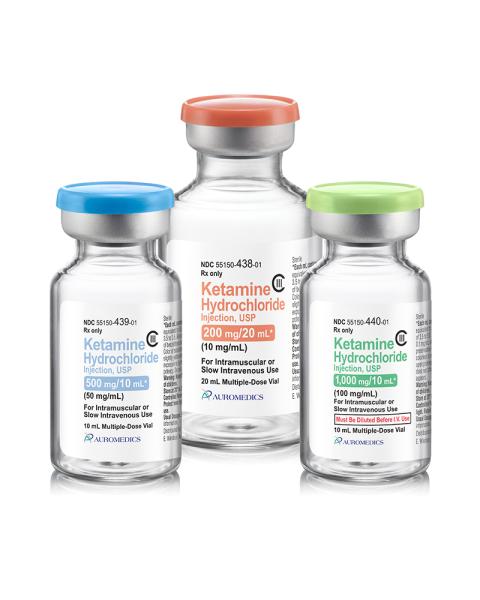Ketamine Dosage
Medically reviewed by Drugs.com. Last updated on Sep 17, 2025.
Applies to the following strengths: 100 mg/mL; 50 mg/mL; 10 mg/mL; 10 mg/mL-NaCl 0.9%; 1 mg/mL-NaCl 0.9%; 50 mg/5 mL; 100 mg/10 mL; 50 mg/5 mL-NaCl 0.9%; 100 mg/10 mL-NaCl 0.9%; 10 mg/mL-NaCl 0.69%; 25 mg/mL; 10 mg/mL-NaCl 0.65%; 2 mg/mL-NaCl 0.85% preservative-free
Usual Adult Dose for:
Usual Pediatric Dose for:
Additional dosage information:
Usual Adult Dose for Anesthesia
IV:
- Induction: 1 to 4.5 mg/kg IV; alternatively, 1 to 2 mg/kg IV at a rate of 0.5 mg/kg/min; (2 mg/kg dose provides 5 to 10 minutes of surgical anesthesia within 30 seconds)
- Maintenance: The maintenance dose should be adjusted according to the patient's anesthetic needs and whether an additional anesthetic is employed. Increments of one-half to the full induction dose may be repeated as needed for maintenance of anesthesia.
IM:
- Induction: 6.5 to 13 mg/kg IM; (9 to 13 mg/kg IM provides 12 to 25 minutes of surgical anesthesia)
- Maintenance: The maintenance dose should be adjusted according to the patient's anesthetic needs and whether an additional anesthetic is employed. Increments of one-half to the full induction dose may be repeated as needed for maintenance of anesthesia.
Comments:
- This drug should be administered slowly over a period of 60 seconds (more rapid administration may result in respiratory depression and enhanced pressor response).
- The larger the total dose, the longer will be complete recovery.
- Because of rapid induction following the initial IV injection, the patient should be in a supported position during administration.
Usual Pediatric Dose for Anesthesia
16 years and older: See adult dosing
Renal Dose Adjustments
Data not available
Liver Dose Adjustments
Data not available
Dose Adjustments
- The individual response is somewhat varied depending on the dose, route of administration, and age of patient, so that the dosage recommendation cannot be absolutely fixed. The drug should be titrated against the patient's requirements.
- Diazepam (2 to 5 mg over 60 seconds), administered in a separate syringe, may be used along with ketamine IV infusion for induction or maintenance of anesthesia. In most cases, 15 mg of IV diazepam or less will suffice.
- Adult patients induced with ketamine augmented with IV diazepam may be maintained on ketamine given by slow microdrip infusion technique at a dose of 0.1 to 0.5 mg/min, augmented with diazepam 2 to 5 mg administered IV as needed. In many cases, 20 mg or less of IV diazepam total for combined induction and maintenance will suffice. However, slightly more diazepam may be required depending on the nature and duration of the operation, physical status of the patient, and other factors. The incidence of psychological manifestations during emergence, particularly dream-like observations and emergence delirium, may be reduced by this maintenance dosage program.
Precautions
Safety and efficacy have not been established in patients younger than 16 years.
Consult WARNINGS section for additional precautions.
Dialysis
Data not available
Other Comments
Administration advice:
- This drug should be administered slowly (over a period of 60 seconds). More rapid administration may result in respiratory depression and enhanced pressor response.
General:
- Because of rapid induction following the initial IV injection, the patient should be in a supported position during administration.
- Since aspiration may occur and since protective reflexes may also be diminished by supplementary anesthetics and muscle relaxants, the possibility of aspiration should be considered.
- This drug is recommended for use in the patient whose stomach is not empty when, in the judgment of the practitioner, the benefits of the drug outweigh the possible risks.
- Atropine, scopolamine, or another drying agent should be given at an appropriate interval prior to induction.
- Purposeless and tonic-clonic movements of extremities may occur during the course of anesthesia. These movements do not imply a light plane and are not indicative of the need for additional doses.
- This drug has a wide margin of safety; several instances of unintentional administration of overdoses of up to 10 times that usually required have been followed by prolonged but complete recovery.
- The larger the total dose administered, the longer will be the time to complete recovery.
- This drug is compatible with commonly used general and local anesthetic agents when an adequate respiratory exchange is maintained.
- The regimen of a reduced dose of this drug, supplemented with diazepam can be used to produce balanced anesthesia by combination with other agents such as nitrous oxide and oxygen.
- Elevation of blood pressure begins shortly after injection, reaches a maximum within a few minutes and usually returns to preanesthetic values within 15 minutes after injection. In the majority of cases, the systolic and diastolic blood pressure peaks from 10% to 50 % above preanesthetic levels shortly after induction of anesthesia, but the elevation can be higher or longer in individual cases.
Reconstitution advice:
- The 100 mg/mL concentration should not be injected IV without proper dilution. It is recommended the drug be diluted with an equal volume of either Sterile Water for injection, USP, Normal Saline, or 5% Dextrose in Water.
Frequently asked questions
More about ketamine
- Check interactions
- Compare alternatives
- Pricing & coupons
- Reviews (171)
- Drug images
- Latest FDA alerts (4)
- Side effects
- During pregnancy
- Support group
- Drug class: general anesthetics
- Breastfeeding
- En español
Patient resources
Other brands
Professional resources
Other brands
Related treatment guides
See also:
Further information
Always consult your healthcare provider to ensure the information displayed on this page applies to your personal circumstances.


